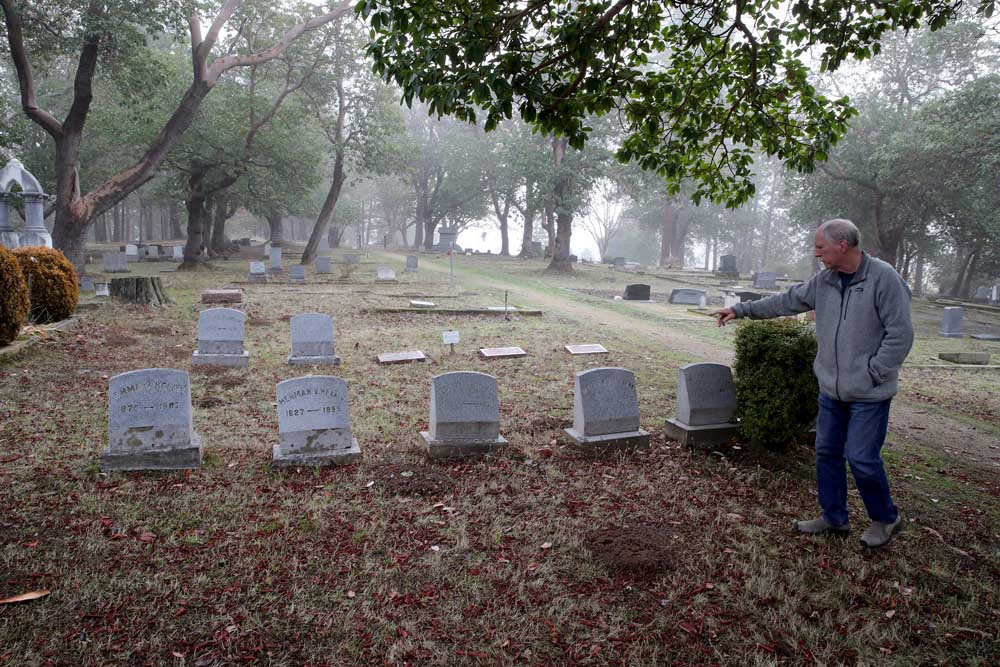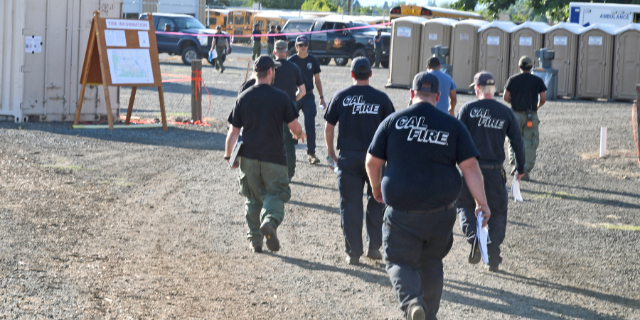Minnie’s story: Girl’s headstone relocated to Jacksonville Cemetery
Published 3:00 pm Monday, December 9, 2024

- John McGlothlin, who has worked with the Friends of Jacksonville’s Historic Cemetery for nearly 20 years on headstone restoration, talks about family history among headstones in the Jacksonville Cemetery.
A headstone for Herminie J. Helms, who died at less than 2 years old during a smallpox epidemic in Jacksonville in the late 19th century, has been relocated from the Oregon Street home where she was first buried to the Jacksonville Cemetery.
Trending
“Minnie” Helms died on Dec. 6, 1868, according to news reports at the time. When her remains were moved to the family plot is uncertain. But when the historic Helms House went up for sale this summer, the real estate agent contacted the city about removing the headstone from a garden on the property.
Jacksonville Cemetery Sexton Rick Shields took possession of the headstone and, with assistance from the Friends of Jacksonville’s Historic Cemetery, placed the marker in the family block located in the International Order of Odd Fellows section.
“Minnie actually passed away during the winter time. It was a bitter winter, so they buried her there at the house,” Shields said. At that time the house was simply a small cabin and accounts suggest the burial was nearby.
Trending
But in 1878, the Helms house was expanded to its current two-story grandeur. The small cabin was incorporated into the house as the kitchen.
“If I’m hearing it right, …where she was buried was going to be in the way of the new house,” said Shields. That may have been when Minnie’s bones were moved.
At the cemetery, Minnie has one of six headstones that are all identical in style for Helms family members. When those headstones were placed is uncertain. There are 12 graves in the block.
Shields enlisted the help of John McGlothlin, who has worked on headstone restoration with the Friends for nearly 20 years. Also helping was Dee Reynar, a board member for the Friends, who is learning restoration.
Placing a marble headstone into the ground could lead to its deterioration, so Shields was able to come up with a base. He used a piece from a headstone that the Veterans Administration had sent to mark the grave of a deceased serviceman, but which had contained an error. The VA sent a corrected headstone and didn’t want the old one back.
Shields carved a slot into the marble piece, but lacked the tools to finish the job. McGlothlin used a Dremel tool to square the corners of the headstone and the base to make sure there was a good fit. That took about 12 hours and seven blades, he said.
The gaps between the stone and the base hole were filled in with a lime-based mortar like that which was used prior to 1900, when Portland cement came into use. It was a common practice when an opening wasn’t always closely cut, McGlothlin said.
The lime-based mortar is made in France and designed for historic restorations. The Portland cement hardens too much to be compatible with the marble and may cause damage to a stone.
“You want to use stuff that’s chemically and physically compatible. As marble ages it gets softer,” said McGlothlin. “You need the mortar to expand and contact with the stone, which the lime mortar will.”
Using the French mortar also ensures that if there is future damage to a headstone repair can be more easily made.
“It’s amazing. All the owners since 1878 had kept the stone and it didn’t get broken or anything,” said McGlothlin.
In addition to the 1868 headstone, a footstone with Minnie’s initials was also relocated to the cemetery from the garden. Footstones were common in the 1800’s and into the early 1900’s, according to McGlothlin. They are small stones that were placed at the foot of a grave and sometimes carried initials.
Upon her passing, newspapers reported Minnie’s death as having occurred at age 1 year and 10 months. The headstone from the Helms house reflects this also, said Dick Meyers, a board member with the Friends group. Neither headstone gives a date of birth, but the age statement suggests that her birth would have been in February of 1867.
Minnie was a member of the prominent and wealthy Helms family. Herman Helms was proprietor of the Table Rock Billiards Saloon on Oregon Street from the late 1850s until his death in 1899. He also served as the county’s administrator for intestate estates and in other public and community roles.
A German immigrant, Helms married another German immigrant, Augusta Englebrecht, in 1862. He was nearly 30 and she was 17. The couple had nine children, although only five of them lived into adulthood. Two other daughters died during epidemics, which were common at the time.
According to reports previously published in the Oregon Sentinel, the ghosts of Minnie and Augusta have been sighted at the family home at Oregon and Pioneer streets.
The spirit of Augusta, an elderly woman who witnessed many murders and suicides, can be heard crying throughout the family home, the Sentinel reported. One of the Helms’ daughters was killed by the estranged husband of another daughter.
Along with Augusta, the presence of a little girl has been sighted. She can be seen at the bottom of the stairs crying, refusing to leave her childhood home, the paper reported.
Editor’s note: This article has been updated to correct Dee Reynar’s name, Augusta Englebrecht’s name and Herman Helms’ work for the county. Also, Friends of Jacksonville’s Historic Cemetery helped with the effort.









